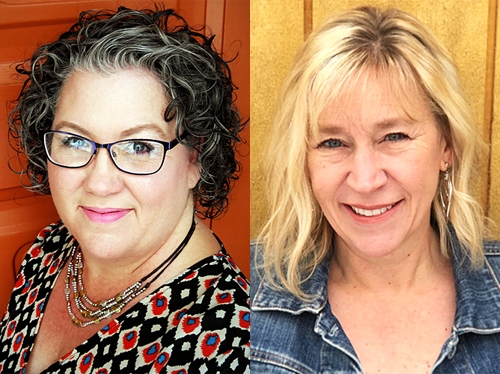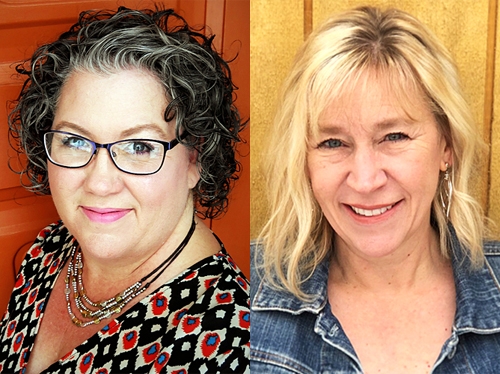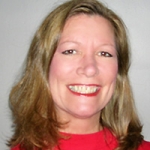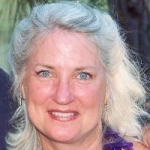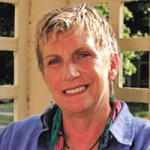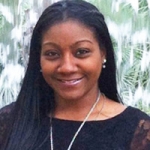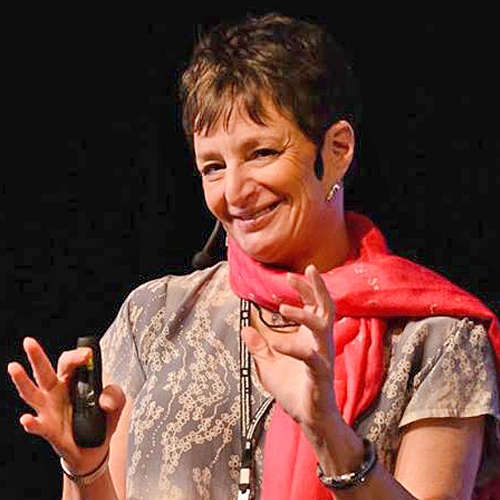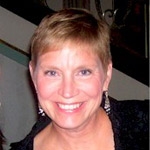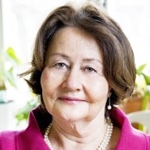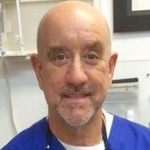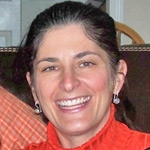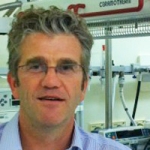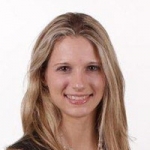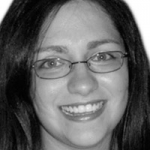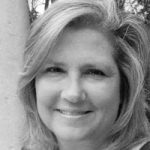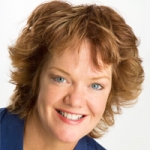 2015 Speakers & Topics
2015 Speakers & Topics
Amy Peterson, an International Board Certified Lactation Consultant, & Mindy Harmer, a Certified Lactation Counselor and Licensed Speech-Language Pathologist, are recognized breast and bottle-feeding speakers. Amy has worked in the field of lactation for the past 22 years focusing the most challenging cases. Mindy is the owner of a Speech-Language Occupational Therapy clinic that specializes in pediatrics. They have a passion for sharing their expertise and strive to give practical information for breastfeeding helpers and parents. For the past 13 years they have studied bottle features and how they impact a baby’s suck. Amy and Mindy’s early collaboration resulted in the publication of Balancing Breast and Bottle: Reaching Your Breastfeeding Goals, revised in 2019. They also have a series of tear-off sheets designed to assist breastfeeding helpers with bottle and pacifier use.
In this presentation, attendees will learn about bottle features that impact a baby’s latch and suck and how to select and use a bottle while protecting the breastfeeding latch and suck/swallow breath pattern. Attendees will also applying elements of breastfeeding to bottle and pacifier use, helping mothers reduce the risk of nipple preference and prolong the breastfeeding experience.
Birdie is an RN with a Master’s Degree in Psychology/Counseling. She is a past president of Postpartum Support International (PSI), past Chair of Education and Training, and is currently serving as Director of Certification. Birdie is a Perinatal Mood Disorders International Trainer with Postpartum Support International and speaks frequently to communities, nursing schools, grand rounds, and conferences. Birdie specializes in the recognition and treatment of pregnancy and postpartum mood and anxiety disorders. She is the coordinator of the Perinatal Mood Disorders Program at Indiana University Health in Indianapolis, Indiana. Birdie is highlighted as a PMD expert in PSI’s DVD that is shown around the world: “Healthy Mom, Happy Family: Understanding Pregnancy and Postpartum Mood and Anxiety Disorders”.
Perinatal Mood and Anxiety Disorders (PMADs) occur more often than people realize. These disorders-depression, anxiety, panic, obsessive-compulsive disorder, and postpartum post-traumatic stress disorder-occur in 20% of childbearing women. Psychosis affects 1-2 women in 1000. PMADs are in the top three causes for maternal death. This talk will describe the spectrum of PMADs, signs and symptoms, risk factors, treatment options, and resources.
Carrie Sue Halsey is a Clinical Nurse Specialist located in Houston, Texas. She earned her advanced nursing degree from the University of Cincinnati and her BSN from the University of West Florida. She is NCC certified in inpatient obstetrics and is an NRP and AWHONN instructor. She is a Trained Breastfeeding Educator and enjoys assisting parents with their breastfeeding goals. Carrie is a natural birth and breastfeeding advocate. Carrie advocates for education and empowerment for nurses and parents through on her blog, PerinatalEmpowerment.com and YouTube Channel. Her experiences of pregnancy, labor and birth as a mother, nurse, writer and educator have made her a passionate crusader for perinatal empowerment.
Nurse support for women in labor decreases medical intervention and increases good outcomes for both mother and baby (AWHONN, 2011). With increasing acuity, charting expectations and use of medical interventions nurses are finding themselves spending less time at their patient’s bedside. The common utilization of induction and cesarean section as means of delivery has contributed to the decline is nurses’ skill for caring for the low risk women in spontaneous labor. This presentation seeks to reintroduce the skills, knowledge and art of nursing that women in labor require for a low risk, low medical intervention birth.
Dr. Cheryl Scott , RN, IBCLC, RLC, has enjoyed working with breastfeeding dyads for 35 years in the field of maternal infant health. Cheryl’s role as a lactation consultant has spanned many professional venues: NICU and Postpartum Inpatient Lactation Consultant, investigative researcher for several human lactation research projects, published author, national speaker. She is the co-chairperson for Kaiser Lactation Associates (KALA) of northern California and assists with the development and maintenance of lactation support services for over 50 medical centers in northern California. Her clinical focus is to provide compassionate care and support while maintaining standards of excellence for breastfeeding families along the full health care spectrum. Dr. Scott and her sweetheart, Bill enjoy gardening with 8 green houses, and small animal husbandry at their small Sustainable Living Center located in Volcano, California.
Skin to Skin for newborn infants in postpartum and the NICU is an essential hospital strategy with many proven benefits for the infant, mother and father, breastfeeding success and saves time for the health care professional while optimizing clinically evidenced based best practices. Skin to Skin safeguards the infant’s adaptation process from intrauterine to extra-uterine life, improves mother/father/infant bonding and attachment, improves milk supply and greatly enhances successful breastfeeding. Join us in learning the many benefits skin to skin and explore many common hospital barriers to skin to skin and the easy solutions to provide mothers and babies access to each other for successful breastfeeding, effective bonding, attachment, and aid in postpartum healing. Our seminar will provide the health care professional with tips for making your job easier as you assist the postpartum mother and infant. Learn evidenced based breastfeeding management skills that are supported by the infant’s inborn hormonal, reflexive and built-in navigation system.
): I received my Neonatal Nurse Practitioner from Georgetown University and worked full time as NNP in a level IV NICU for 23 years. Subsequently I received a Family Nurse Practitioner Degree from State University of New York Health Science Center Syracuse and then a Post Master’s Degree as a Psychiatric Nurse Practitioner from University of Buffalo specializing in Reproductive Psychiatry. For me, this brought my NICU practice full circle treating the entire family. In 2013 I transitioned to academia and am currently on faculty at the Pomeroy College of Nursing at Crouse Hospital. I also spearhead programs at Crouse Hospital for maternal mental health. I have been a lecturer/educator for NANN, AWHONN, New York State Nurse Practitioner Association and a variety of other venues.
Dr. Frank J. Nice has practiced as a consultant, lecturer, and author on medications and breastfeeding for 40 years. He holds a Bachelor’s Degree in Pharmacy, a Masters Degree in Pharmacy Administration, Masters and Doctorate Degrees in Public Administration, and Certification in Public Health Pharmacy. He served in the US Public Health Service with 30 years of distinguished service. He recently retired after 43 years of government service and currently is self-employed as a consultant.
Dr. Nice has published Nonprescription Drugs for the Breastfeeding Mother, 2nd Edition and The Galactogogue Recipe Book. Dr. Nice has also authored over 50 peer-reviewed articles on the use of prescription medications, Over-the-Counter (OTC) products, and herbals during breastfeeding, in addition to articles and book chapters on power, epilepsy, and work characteristics of healthcare professionals. He has organized and participated in over a four dozen medical missions to Haiti. Dr. Nice continues to provide consultations, lectures, and presentations to the breastfeeding community and to serve the poor of Haiti.
Sources of information for medication use during breastfeeding will be presented and reviewed. Tools and techniques developed by the author for evaluating medication use during breastfeeding will be introduced. Potential adverse effects in children of mothers who are breastfeeding and taking medications will be reviewed and discussed. Various categories of medications that are usually compatible with breastfeeding will be identified. Using the material presented, healthcare professionals will be able to counsel mothers who are breastfeeding and taking or will take medications (prescription, over-the counter, herbal, and complimentary).
Gina has been the CEO at NILMDTS since October 2011. Gina has extensive expertise in nonprofits and has personally been touched by the services of NILMDTS. In 2007, Gina and her husband lost their first son David du to Potter’s Syndrome. Now I Lay Me Down to Sleep captured images of David. Not even a year later, the Harris’ lost their second son, Ethan from another condition called hydrops and cystic hygromas. Because his condition was so severe and the shock they were in, the couple did not get pictures of him. Gina understands from firsthand experience the significance NILMDTS images have on the healing process. Gina spent 12 years at a national youth-serving nonprofit and was the executive director for five of those years. Gina is a sought after national speaker and is a published author. She has been featured in major media including CNN, The LA Times, The Washington Post, Extra, NBC, People Magazine, and dozens of local newspapers and radio shows. Gina has a Master’s of Science in Nonprofit Management and a bachelor of arts in television news and video communications.
Cheryl Haggard is the founding parent of Now I Lay Me Down to Sleep. She is a stay at home wife to Michael and the mother of Chase, Anna, Natalie and baby Maddux. NILMDTS was formed after the birth of her fourth child Maddux Achilles Haggard, who was born with the rare condition called Myotubular Myopathy. Cheryl is extremely active in all her children’s activities. She enjoys the thrill of life, and has participated in events such as skydiving. She also knows the value of life and donated a kidney to a friend in 2007. Cheryl enjoys photography, hiking, boating, sunny days, thunderstorms, Texas hold ‘em poker, Colorado microbreweries, her two dogs and three cats, as well as everything about Tim Tebow. She and her family currently reside in the foothills of Denver, Colorado. Cheryl believes that the pain of losing a child never gets easier, and that you just become a stronger person to carry that pain throughout your life.
Pregnancy and birth are miraculous journeys, but joy turns to sadness when a baby dies or is born still. Now I Lay Me Down to Sleep (NILMDTS) helps families capture the love of their baby with a free gift of heirloom quality photographs. It may not initially occur to parents to photograph their baby, but parents who do receive images of their baby are extremely grateful as these photographs play a significant role in the healing process. This presentation will discuss how to give the best care to grieving parents, the benefits of remembrance portraiture, and how to capture the only moments parents will spend with their baby.
I attended Texas Christian University and completed my Bachelor of Science in Nursing in 2008. I started my nursing career in a 107 bed level III NICU at Parkland Memorial Hospital, where I had the opportunity to care for some of the sickest babies. After my time there, I transferred to another hospital where I worked in labor & delivery, Antepartum, OR, and continued to care for babies. In 2013, I had the opportunity to complete my masters in nursing education at Walden University and began working as a perinatal nurse educator. I am currently the Nurse Residency and Clinical Simulation program coordinator at University of Texas Southwestern Medical Center, as well as the chair of the DFW section of AWHONN, and the host chair for the 2016 National AWHONN Conference. In my free time I enjoy working out, playing with my dog, Winnie, and serving at my church.
Every day throughout the country women’s health nurses encounter patients that have suffered from a neonatal loss. Nurses play an integral part in helping families to navigate through losing their infant. As perinatal nurses, it is important that we know how to best physically and mentally care for our patients during this difficult time. While our patients needs remain our primary focus, it is also imperative that we are able to recognize and process our own emotions as we go through this experience with our patients. The inability to acknowledge not only our own feelings, but those of our colleagues, can lead to increased stress, compassion fatigue, and healthcare provider burnout. The use of individual and team strategies to help recognize and confront our emotions as healthcare providers not only allows us to better support and care for our patients, but also provides a healthy work environment.
Karen H. Strange is a Certified Professional Midwife (1996), American Academy of Pediatrics/Neonatal Resuscitation Program Instructor (1992).
She is founder of the Integrative Resuscitation of the Newborn workshop, which includes the physiology of newborn transition. She teaches the “when, why and how” of helping newborns that are either not breathing or not breathing well, with incredible clarity. She helps the provider have a sense of what the baby is experiencing which leads to a more appropriate response to newborns in need. Karen has done over 900+ hours of debrief/case reviews regarding resuscitation. She is an international speaker and has taught over 9,000 people worldwide. There are many neonatal resuscitation instructors but Karen teaches practical neonatal resuscitation, regardless of the place of birth. And her teachings instill a strong sense of confidence and competence in providers, so they can respond in the least traumatic way.
This lecture will be an in depth look at what is involved when meconium presents itself at birth. What the evidence based studies repeatedly say, what the guidelines state, and how the standards of care do not reflect the studies. This lecture will clearly explain and go through why meconium occurs, what meconium stained water means, and then how to proceed. It will offer tools for further inspection and decisive action when it is a problem. It will differentiate and discuss the different definitions between light, dark, thin, thick and particulate. A further understanding of Meconium Aspiration Syndrome MAS will be covered. The entire presentation will be based on the latest evidence-based studies regarding meconium, suctioning and intubation (its purpose and what it really does).
Karen Kerkhoff Gromada, MSN, RN, IBCLC, FILCA works part-time on special lactation consultant projects for TriHealth Hospitals (Cincinnati, OH) after more than two decades of private and hospital IBCLC practice. She has worked as an adjunct clinical instructor for the University of Cincinnati College of Nursing and has experience in labor and delivery, childbirth education and postpartum discharge care. A La Leche League leader since 1975, she formed the first LLL group for mothers of multiples after the birth of her twin sons and still leads this group. The experiences of the group’s mothers provided the basis for her book Mothering Multiples: Breastfeeding and Caring for Twins or More. Her numerous articles and chapters about breastfeeding multiples have been published in professional and lay publications. A former ILCA president (1994-96), she was designated Fellow of the International Lactation Consultant Association (FILCA) in 2008.
Topic: Breastfeeding multiples: Learning the dance of breastfeeding and lactation with two, three or more newborn partners - [View Abstract]
Multifetal pregnancies – twins, triplets and higher-order multiples – are at increased risk for pregnancy and birth-related complications. However, many women, and even their obstetric care providers, don’t seem to understand the literal meaning of the “high risk” label. For many, it will change every aspect of long-held desires and plans for pregnancy, birth, type of obstetric care provider and birth place, unless that woman receives the knowledge and support needed to take “control” of her pregnancy and her babies’ birth. This session will look at the increased risks associated with multiple pregnancy and birth, and the meaning “high risk” should have for the expectant mother. Strategies will also be discussed about ways to help empower these women so they become partners with their obstetric healthcare providers in order to achieve childbirth goals.
The incidence of multiple births has increased over the last two to three decades, as has the desire of these women to breastfeed their multiples. However, preterm birth and medical interventions often affect breastfeeding initiation and frequent breastfeeding/pumping. Many mothers must establish lactation via milk expression and later transition one or more multiple-birth infants to breastfeeding. The behaviors of a typical breastfeeding dyad have been compared to a dance. With multiple newborns a mother must learn each infant’s unique breastfeeding dance. Is it any wonder that mothers of multiples often need extra support with breastfeeding management. This session will review typical issues affecting breastfeeding initiation with twins, triplets or more, and discuss strategies for assisting the mother as she learns the breastfeeding dance of each unique multiple-birth infant and then adapts each dance as her newborns/infants grow.
Kerstin Uvnäs Moberg got her MD and a PhD in Pharmacology at the Karolinska Institutet in Stockholm, Sweden. She has been employed as a full professor of Physiology at the University of Agriculture in Uppsala, Sweden. She has worked with research linked to the physiology of labor and breastfeeding for more than 30 years. The focus of the research has been on the role of oxytocin and sensory stimulation, in particular stimulation of cutaneous sensory nerves during labor, skin-to-skin contact after birth and breastfeeding. She has worked with animal experiments and also studies involving humans. She has studied the physiological mechanisms involved in birth and breastfeeding and also short and long term physiological and behavioral maternal adaptations induced during birth and breastfeeding.She is also working with the role of oxytocin during human animal interaction and in menopausal women.
Pregnancy, labor, birth and skin-to-skin contact after birth form an entity. Oxytocin is being released during all these phases; by estrogen during pregnancy and by sensory stimulation during birth (the Fergusson reflex) and skin-to-skin contact (activation of cutaneous nerves). Oxytocin in the circulation and the activity in the autonomic nervous system stimulate uterine contractions during labor. Oxytocin is also released from nervous pathways in the brain during birth and during skin-to-skin contact after birth. Mental and physiological adaptations are induced, which facilitate motherhood, by oxytocin released from nerves in the brain. The anti-stress effects induced by oxytocin are particularly strongly activated by skin-to-skin contact. It is obvious that any intervention during birth, that hinders activation of oxytocin release e.g. elective Cesarean Section, or blockade of the Fergusson reflex during vaginal birth by e.g. epidural analgesia, might interfere with the oxytocin related adaptations. Separation of mother and baby after birth, the presence of clothes as well as administration of certain types of anesthetic drugs, such as marcain, which block the activation of cutaneous sensory nerves during skin-to-skin contact, might counteract the physiological and behavioral effects induced during skin-to-skin contact after birth. Examples of such negative consequences will be discussed in the presentation.
Dr. Martin Kaplan was born in Chelsea, Ma. He completed his undergraduate degree at The University of Massachusetts and then attended Tufts University School of Dental Medicine. After earning his D.M.D. degree he completed a pediatric residency at Montefiore Hospital in New York.
Dr. Kaplan practices exclusively in Stoughton, MA. He continues to take update his laser education by regularly attending the Academy of Laser dentistry Annual meeting where is also contributes as a lecturer ans laser safety officer. He is one of only a handful of pediatric laser dentists who utilizes lasers for the treatment of infants with breastfeeding issues related to frenum attachment problems.
He is a member of the:
• American Academy of Pediatric Dentistry
• Massachusetts Academy of Pediatric Dentistry
• American Dental Association
• Massachusetts Dental Society
• Academy of Sports Dentistry
• Academy of Laser Dentistry
Academy of Breastfeeding Medicine
When not practicing dentistry he enjoys Karate and has attained the level of 4th degree black belt.
This presentation will provide an introduction to what lip and tongue-tie are, the basics of assessment for lip and tongue-tie, and the possible consequences of not providing treatment once a lip and/or tongue-tie have been identified. Assessment of lip and tongue-tie is complex, and must include information from health care provider physical observation and digital exam combined with an extensive intake history to provide the full picture and allow an objective evaluation. Intake forms will be available for the attendees, and cases of lip and tongue-ties will be presented through numerous clinical photos. Options for treatment will be discussed, along with the possible long term consequences of not providing treatment.
Michelle Emanuel has over 19 years experience as a neonatal / pediatric occupational therapist, which includes neonatal intensive care unit, pediatric critical care, outpatient and a private practice, with a specialty in using soft tissue manual therapy assessment and treatment. Michelle has a wide variety of skills including newborn/infant development, pre and perinatal psychology, Autonomic Nervous System Regulation and Resiliency, infant sensory processing, baby massage, craniosacral therapy and other forms of bodywork. She specializes in bodywork for babies with torticollis, plagiocephaly and tethered oral tissues. Michelle is licensed and registered as an Occupational therapist, a national board certified Reflexologist and 200hour Registered Yoga Teacher. She is also certified in CranioSacral Therapy, Divine Sleep™ Yoga Nidra, Reflexology, Infant Massage, Baby's First Massage, Butterfly Touch Massage, Neonatal Oral Motor Assessment Scale (NOMAS) and the Infant Behavioral Assessment. In addition to developing the TummyTime! method and a BabyYoga curriculum, she teaches both parents and professionals in the essentials of baby development and care.
The Social Nervous System, comprised mainly of cranial nerves 5, 7, 9, 10, 11 and 12, is a newborn baby’s special skill and ability. The combination of using face, jaw, tongue and throat muscles along with head turning to mother or father’s voice have profound influence on how baby is able to bond, attach and especially breastfeed. Babies are born with sophisticated abilities to socially engage, and when we don’t see this happening easily for babies, we want to have a way to address this. Professionals will be provided with simple and easy ways to evaluate this system and provide parent support and education for how to maximize full function. The connection between the function of this system and baby’s health will be explored in this one hour talk. Michelle will also blend the neuroscience of touch and the benefits for bonding, attachment, breastfeeding and thriving in our hectic, fast paced world.
Dr Embleton has worked in neonatal medicine for the past 25 years, completing clinical training and a research doctorate in neonatal nutrition in the UK, and a neonatal fellowship in Vancouver, Canada. He has worked as a Consultant Neonatal Pediatrician in Newcastle, UK since 2002, one of the largest UK neonatal units, caring for sick preterm and term born neonates. He leads a broad portfolio of research focused on nutrition and gut health in preterm infants. Areas of work include determining patterns of early gut microbial colonization, and how these may predict the development of necrotizing enterocolitis (NEC) and sepsis. He is a project team member of large neonatal feeding trials recruiting >5000 infants in the UK, as well as coordinating mechanistic studies using microbiomic and metabolomic analyses. He chairs the multi-disciplinary UK Neonatal Nutrition Network (N3) and is a member of the Committee of Nutrition for ESPGHAN.
There is increasing evidence that the pattern of gut microbes affects a range of health and disease outcomes for both term and preterm infants. At birth, the gastro-intestinal tract is largely sterile, but rapidly becomes colonized by organisms in the environment, contact with the mother and from breast milk. The numerous advantages of breast milk throughout the life-course may be due, in part, to the patterns of early gut bacteria, and the interactions between milk, microbes and the immune system. These interactions are likely to be pivotal to the development of infections and necrotising enterocolitis (NEC, a serious inflammatory gut complication) in preterm infants. Data show that early colonisation in preterm infants on NICUs is profoundly abnormal. However, knowing how these patterns are affected by milk type, immuno-nutrients (such as lactoferrin), antibiotics and probiotics is important as it may allow the design of strategies to improve health outcomes.
Dr. Robin Elise Weiss is a childbirth educator, doula, and author of more than 10 books on pregnancy and parenting. She is the past President of Lamaze International and currently serving on the Board of Directors. She also runs one of the oldest pregnancy websites, pregnancy.about.com. Robin and her husband, Kevin, are raising their eight children in Louisville, KY, USA.
Take a tour of the Lamaze International’s six Healthy Birth Practices to see what people can do to make their birth safer and healthier. These six simple steps can be employed in most birth settings with a minimal of change. Using a model of empowerment, the Lamaze International classes are designed to help women become informed and make choices that work towards safer, healthier births and babies.
Sandra received her BSN from Shenandoah University in Virginia in 2005 and began work at Yale-New Haven Hospital in Labor & Birth shortly thereafter. After gaining 3 years of L&D experience at Yale, she relocated to VT and took a job in the Birthing Pavilion at Dartmouth-Hitchcock Medical Center in Lebanon, NH where she stayed for 4 years gaining experience in their LDRP. While at Dartmouth, she obtained her MSN in Nursing Education from Norwich University. In 2014, she has accepted the role of Birth Center Nurse Educator at the University of Vermont Medical Center in Burlington, VT. She is certified in inpatient obstetrics as well as electronic fetal monitoring, an NRP regional trainer and an AWHONN Fetal Monitor Instructor. Sandra is the section Chair of the VT AWHONN section and a 2015 AWHONN emerging leader. She lives in Williston, VT with her three children. She is very passionate about Women’s Health, Obstetrics, and Newborns!
One of the most common disorders seen in pregnancy today falls into the realm of “hypertensive disorders of pregnancy” occurring in 12-22% of pregnancies. Understanding the classification and management of this population of patients will allow for better care and improved outcomes. Not only do these disorders account for 17% of maternal mortality in the United States but also account for one of the leading causes of premature birth which increases neonatal morbidity and mortality. National and International organizations have developed guidelines for the management of hypertensive disorders in pregnancy to reduce maternal mortality. These organizations include the American Congress of Obstetrics and Gynecologists (ACOG), National Institute for Health and Clinical Excellence (NICE), and Society for Obstetricians and Gynaecologists of Canada (SOGC). This presentation will review some of the guidelines developed and the importance of an interdisciplinary approach to the management of patients with hypertensive disorders of pregnancy.
Shelly Lopez Gray is a registered nurse behind the blog Adventures of a Labor Nurse: the Highs and Lows of Labor and Delivery. She writes about the secret (good) work of nurses and provides information for women before, during and after their pregnancy as well as resources for nurses for professional growth and development. She works at the Houston Medical Center. Shelly volunteers teaching prenatal classes to women at a pregnancy crisis center and provides breastfeeding information to mothers at a teen clinic. Shelly is dedicated to the health of moms and babies and genuinely believes that every nurse has the potential for greatness.
Technology has become a staple of American lifestyle. The majority of healthcare providers and patients utilize social media on a daily basis. Information is now readily available and easily accessible online and through a variety of social media outlets. Healthcare providers and patients both independently search for information related to care or practice. Online information is abundant, instantaneous, and often incomplete. Media tools are capable of engaging and educating patients and providers. These outlets maximize exposure of information and provide focused information to specific populations. Assessing a need for complete, current, evidence-based information relevant to the bedside nurse and the clients in their care resulted in the creation of a website dedicated to patient and provider education. Articles providing education aimed at particular populations or topics are published weekly and promoted through social media outlets. Analytics are reviewed to evaluate engagement and compared to national organizations, revealing consistently high engagement.
Dr Kathleen Baird is a Senior Midwifery Lecturer at the School of Nursing and Midwifery, Griffith University and Director of Midwifery and Nursing Education, Women’s and Newborn Service, Gold Coast Hospital. For the last fifteen years Kathleen’s main research interests have centred around intimate partner violence, with a focus on violence during pregnancy. Kathleen’s PhD explored women’s experiences of partner violence during pregnancy, birth and the postnatal period. Kathleen has been involved with domestic violence training of qualified health professionals, undergraduate and postgraduate health students and members of the voluntary services for several years. Kathleen is currently involved with several research projects in relation to intimate partner violence and the role of health care and sits on the Queensland Domestic and Family Violence Prevention Council.
Theresa Nesbitt, RN MD ("Dr. Theresa") is an Obstetrician-Gynecologist with special training in Maternal Fetal Medicine. Her interests these days lie in promoting lifelong wellness for women with a focus on nutrition, reproductive health and breastfeeding. She is the Director of Family Health Coaching, editor of Babies and Breastfeeding Magazine and author of Evolutionary Eating: How We Got Fat and 7 Simple Fixes. She anticipates publication of her newest book Building a Baby Brain Bite by Bite - How to Eat Before, During and Afte Pregnancy in 2016. Dr Nesbitt developed an interest in breastfeeding because of she observed that although many pregnant women PLAN to breastfeed, they are not really PREPARED to do so. Her interest in brain growth and development, nutrition and developmental kinesiology have helped her to look at breastfeeding and human milk from a new perspective.
A fundamental difference between plants and animals is that animals have a brain. Mammals were able to increase brain size by developing 2 special adaptations that facilitate transfer of specific brain building nutrients during gestation via the placenta and after birth via the mammary glands. It’s important for mothers to nourish and replenish their bodies before, during and after pregnancy because it is only the females that must “build a brain from scratch”. This talk will cover superfoods, suspect foods and supplements that promote wellness in mothers and babies by restocking maternal body stores (the pantry). The biology of morning sickness, why women have curves and the facts of fictions of prenatal vitamins are discussed.
 Dr. Speakers Full Name
Speaker Credentials
Dr. Speakers Full Name
Speaker Credentials
Annet Mulder first became interested in breastfeeding in the year 2000, when she became a mother for the first time. During and because of her own breastfeeding experiences, in 2002 she became a volunteer with the Dutch breastfeeding Organization and in 2008 sat for and passed the exam administered by the International Board of Lactation Consultant Examiners. As an International Board Certified Lactation Consultant, she now
Annet Mulder first became interested in breastfeeding in the year 2000, when she became a mother for the first time. During and because of her own breastfeeding experiences, in 2002 she became a volunteer with the Dutch breastfeeding Organization text text text text more name mulder first became interested in breastfeeding in the year 2000, when she became.
 Dr. Speakers Full Name
Speaker Credentials
Dr. Speakers Full Name
Speaker Credentials


